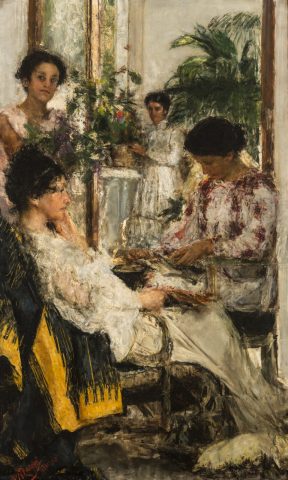13 times at the Venice Biennale but he is still to be sanctified
- Studies on the grid technique.
- Antonio Mancini, Low Tide, 1874; Oil on panel, 80×130 cm.
- Antonio Mancini, The Ministrel, 1915; Oil on canvas, 141×81 cm.
- Antonio Mancini, Mengarini Family, 1906; Oil on canvas, 198×135 cm.
- Antonio Mancini, Portrait of Mrs. Pinelli with her daughter, 1911; Oil on canvas, 60×95 cm.
Tomorrow a conference will present the results of scientific analysis that likely will reinforce what art history already stated. Italian Antonio Mancini was not only a pillar of XVIII century painting, but also a great innovator of this medium and among the first to use extra-pictorial elements such as glass, mother-of-pearl, fragments of mirror, silver and gold papers to empower the colours’ expressiveness. And he was probably also among the very first using the so called “gridiron” (graticola in Italian), that was a system providing reference lines by two proportional wire grids, one to be placed between the artist and the model while the other directly leaning on the canvas. Thanks to this method, also allowing him to skip preparatory drawing, he was able to paint extremely precise and very instinctive portraits of the subject matter which made him famous, Neapolitan street urchins.
Scientific analysis, executed by Fabio Frezzato and Gianluca Poldi, have been carried out in occasion of a remarkable exhibition organised in Milan by Bottegantica, an established fine art gallery specialized in Italian painting from the XVIII century that CFA mentioned a few months ago in occasion of their first time at the Biennale des Antiquaires in Paris. The museum-standard show gathers together nearly 40 main pieces by the artist, on loan from private collections mainly from from Milan, Rome and Naples, but also France and Switzerland. In fact Mancini was among the few Italian artists of his time obtaining international recognition. Early in his career he met Belgian Count Albert Cahen of Antwerp who helped him to present his paintings in Paris, where he moved in 1875 also thanks to his friendship with Mariano Fortuny – Mancini gave him a painting, titled Jeune garcon tenant une pièce de monnaie, and the work went under the hammer at l’Hotel Drouot, when Fortuny passed away later that year, giving Mancini a first hint of notoriety. Once in Paris, also thanks to Cahen, he met artists such as Manet, Degas, Gérome, Meissonier, Boldini, De Nittis, and set a commercial agreement with Adolphe Goupil. In 1901 he also travelled to London, in 1904 he exhibited in Dusseldorf, in 1905 in Monaco, in 1907 he was in York, Dublin, and again in London, in 1911 he visited Hague. In 1908 he worked with German fine art delaer Otto Messinger, while in 1911 he signed an agreement with French businessman Fernand Du Chêne De Vère, who hosted Mancini at Villa Frascati in Rome until 1918. Between 1897 and 1929 he took part to 13 editions of the the Venice Biennale, which celebrated his mastership with a solo show in 1920. A few artists of his time can count on such an international career.
The show at Bottegantica includes some pivotal pieces such as the virtuous self portrait Mancini painted around 1880, probably while he was already suffering of mental disease – the artist spent some months in a sanatorium in Naples between 1880 and 1881. His eyes wide opened, a vibrant corn in his mouth, a sketchbook in his hand, the easel in front of him, and a painting on the background. The artist is surrounded by his obsessions, and draws references to Naples, Alessandro Manzoni, and Mariano Fortuny’s bust sculpted by Vincenzo Gemito. Probably he is looking himself at the mirror, but differently from some of his most effective portraits, his nails are clean, somehow innocent. While, for instance, those of the girl in Two Dolls (1878) are surprisingly dirty and clash with the lavish jewels and precious robe she is wearing. Also the nails of the right hand of Luigi Gianchetti’s portrait are dirty (1878), but not disturbing. favourite Manicini’s model is here simply portrayed as a boy who can’t wait for getting back to more engaging games than practising music, or sitting for a portrait.
Unfortunately the show is closing this weekend, but those who haven’t been able to visit it will certainly find relief in the new comprehensive catalogue of Mancini’s works that is going to be published next year and rumours say that a main international exhibition is currently under discussion. Is Paris getting ready to welcome again this talented foreigner?
December 16, 2016





